1989 Canadian Grand Prix race report
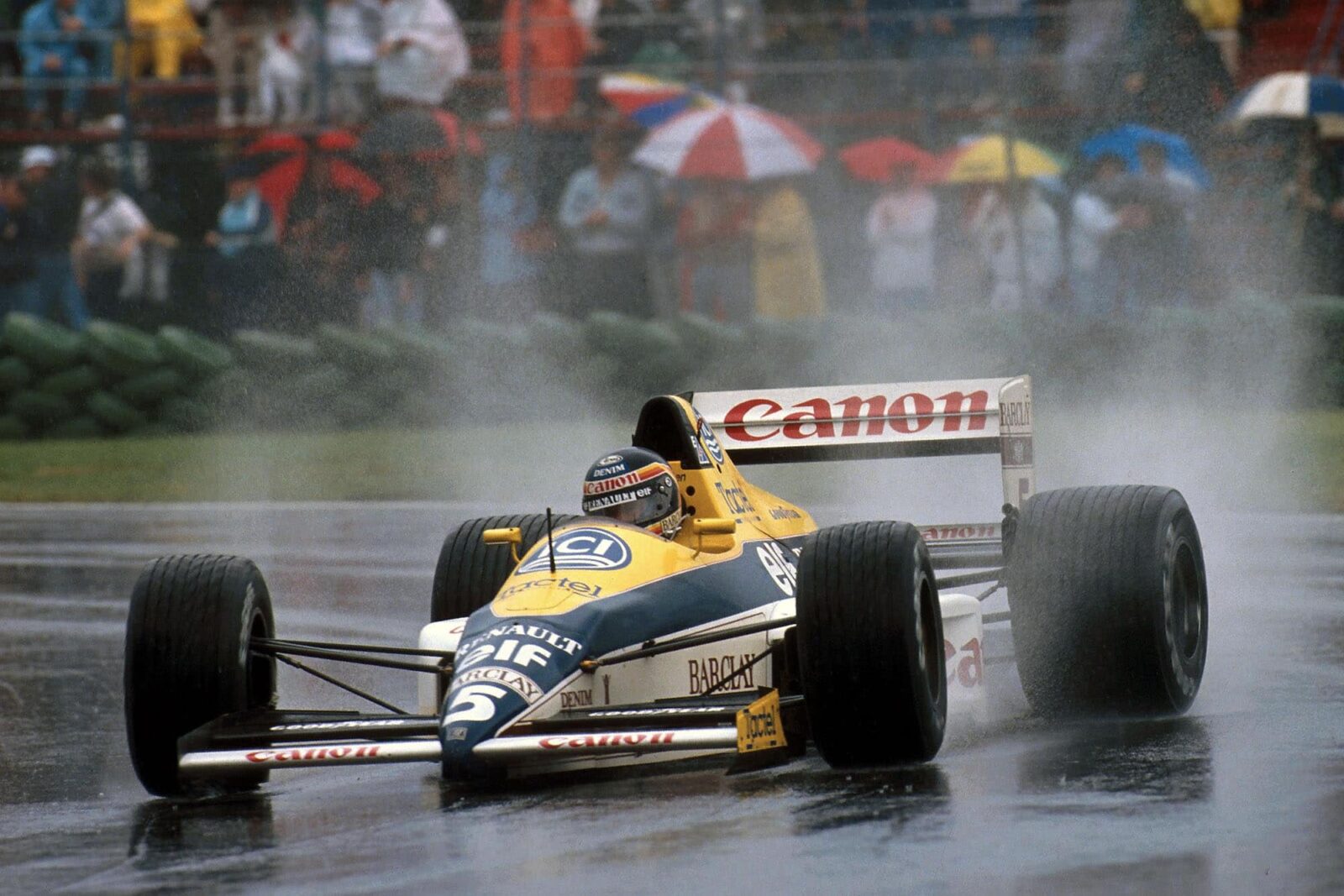
Thierry Boutsen claimed his first career win for Williams in the wet
Motorsport Images
A fillip for racing
Success came early for Renault, after all. it came in appalling conditions in Montreal, when the rain which had wrongly been forecast for Friday and Saturday finally turned up on raceday at the Circuit Gilles Villeneuve.
Only the day before, over a breakfast for the British specialist and daily Press, Renault Sport boss Patrick Faure had outlined the way he saw the 1989 season. “We’re happy with the progress we’ve made this year after our two years away, and already we’ve had two races in the points. We asked Bernard Dudot to go first for reliability and, touch wood, we’ve succeeded. Ron Dennis has said he sees Renault as McLaren’s closest challenger.”
He’s a smart cookie, the clear-thinking son of one of President Mitterand’s closest friends. Though he was one of the those keenest to see Renault pull out at the end of 1986, he was also one of the keenest to see it return this year, and is shrewd enough not to inveigle the press into expecting too much.
“Frankly, we don’t expect to finish the year level with Honda on development. After all, it’s a year ahead of us. But we hope to finish not too far behind. We have always said 1989 is our learning year. We’ve been surprised this year, it’s true, and we hope maybe to win a race by the end of it . . .”
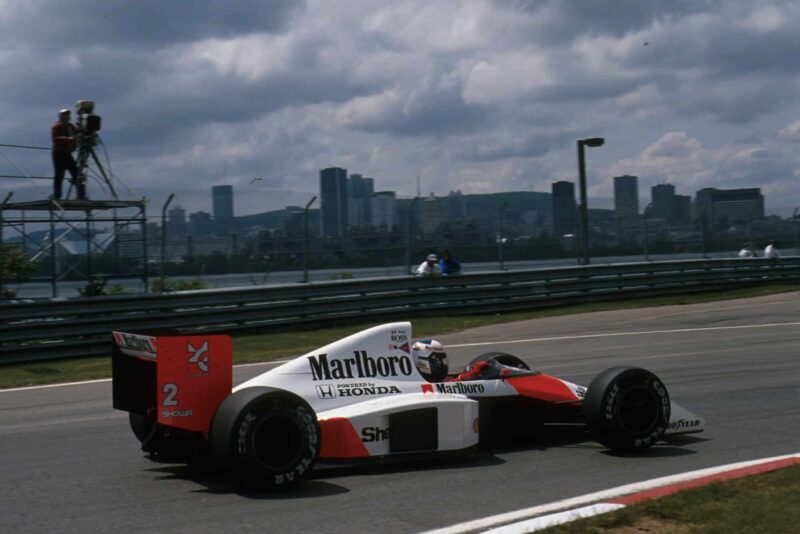
Alain Prost set the fastest qualifying time in his McLaren
Motorsport Images
Courtesy of Thierry Boutsen, that win came a lot sooner than expected, upsetting the Formula One applecart as the Belgian became the first driver outside the Senna/Prost/Mansell/Berger/Piquet/quintet to win a Grand Prix since Keke Rosberg triumphed in Adelaide in the last race of 1985.
There are times when one can be drawn to conclude that Boutsen drives hard if the car feels good, less hard when it doesn’t, that he takes his mood from his machinery. In Canada, however, he simply got his head down and charged throughout.
After a hailstorm some three-quarters of an hour before the start, the dark skies had cleared somewhat, enticing Nigel Mansell, Alessandro Nannini and Luis Sala to switch to slicks at the end of what was the second formation lap, Gerhard Berger having delayed the first start by stalling on the grid. By that time the man in charge of the pit-road exit lights had gone awol, so when Mansell went to leave, thinking the race had already started, he found no red, yellow or green lights, nor anyone who could give him valid direction. After a quick look around, he did what any self-respecting racer would do, and left in a hurry.
Nannini arrived as the yellow lights began flashing. In accordance with the drivers’ briefing, he joined with caution. Sala arrived later still, by which time the startline red lights had been switched on, so he waited until the field had departed before joining in. By fortune of circumstance, he was okay. Mansell and Naninni were black-flagged and disqualified, and Ferrari and Benneton’s subsequent appeal against the penalty was turned down in Montreal ten days later.
If the man at the lights had the same bored, unhelpful attitude to his job as the Canadian in the Press room, it’s not difficult to see why the cock-up occurred. It’s less easy to see why FISA didn’t back the teams a little more, for once.
When the rain returned by lap eleven, the complexion of the race changed yet again, and for Boutsen it could have been disastrous, since that was the very lap on which he stopped for slicks! And it wasn’t a particularly quick stop, either, as a front wheel was reluctant to come off. “After that, I treated every lap as a crash or win lap,” said the Belgian, who came in again on lap 19 to revert to wets.
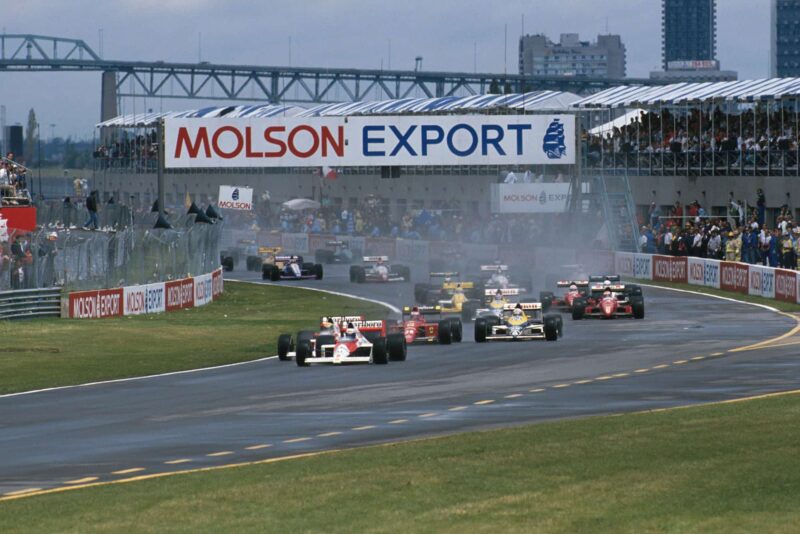
The race starts under wet conditions
Motorsport Images
All this time, Ayrton Senna had been carving back towards the lead he lost on lap four when he pitted for slicks. In qualifying he’d been upstaged by team-mate Alain Prost, who was perfectly happy with his Honda and was quite confident he would have retained the pole anyway even if high wind hadn’t made Saturday a slower session. Prost got the jump at the start and led comfortably at the end of the first lap.
At the end of the second he pitted, it was thought for slicks, but after another slow lap he was in again. The rear mounting point on the front upper-left wishbone had pulled out of the monocoque, and his race was over. It was an extraordinary occurrence by McLaren standards, but worse was to come for the Woking superteam.
As Senna fought back from his tyre stop, the Canadian Grand Prix appeared to have polarised into a battle between the McLaren and Ricardo Patrese, who had confidently assumed the lead on his wets and would hold it until his one and only stop on lap 35. All year the Italian has been driving at his peak, as if the Renault engine has given him a new lease of life. Senna got close on his slicks by lap 11, having worked back to second as the track began to dry out, but as the rain returned he was working overtime to keep the MP4/5 on the grey stuff. When he called in for fresh wets on lap 21, it was Derek Warwick who became the Williams’ closest challenger.
Warwick. What a warm feeling it instilled seeing the perennial hard-trier as high as second, and closing slightly on Riccardo. In media terms, he is probably the closest to American heroes Mears, Mario or Unser Jnr in his approachability, yet always luck seems to run against him. This time the Arrows was running well, he revelled in its balance, and you began to feel, just maybe, that a really good result was on the cards.
When Patrese stopped and Derek assumed the lead for four glorious laps, there were few Pressmen who didn’t fervently hope his luck was about to change. Subjective? You bet, but the Jerseyman is universally popular.
Bit by bit, as Warwick had been catching Patrese, so Senna had been catching them both, his fresh wets superior to their worn wets. On lap 39 the inevitable occurred, and Derek surrendered the lead. Second would still have been his best F1 result, but even that was asking too much. On lap 41 something in the bottom end of the Arrows’ Cosworth DFR broke, and that was that. Patrese resumed second place, but by now the rest of the opposition had thinned out so much that Boutsen was up to third.
Berger had been looking hard at Patrese’s lead on lap six, when the Ferrari’s gearbox packed up. After Phoenix, John Barnard had given guidelines for the repositioning of the alternators, and was livid to find in Canada they hadn’t been sited properly. Mansell’s unit had also been playing up on the warm-up lap, so even if he hadn’t been disqualified, it is highly doubtful whether he would have finished. A week after the race, Ferrrari let it be known that Barnard wouldn’t be staying. The Englishman was adamant he wants to say in the UK; Ferrari wants a new technical head based in Italy. End of story.
Eddie Cheever had run ahead of Warwick, only for his electrics to die on lap four. Gabriele Tarquini had been fighting for seventh place with Rene Arnoux when a touch from the Ligier helped the AGS into retirement against the tyre wall in Turn One. Mauricio Gugelmin and Luis Sala also departed the fray on lap 12, the Brazilian’s electrics failing after he’d already been delayed by pitting at the same time as team-mate Capelli, the Spaniard making it two damaged Minardis when he clouted the wall heavily; team partner Piero Martini had already been helped out of an initial eighth place on the opening lap when Stefano Modena’s Brabham aquaplaned into him and put both in the wall. And Modena’s team-mate Brundle? The race was tailor-made for him, but he didn’t even get into official qualifying after a series of silly problems in prequalifying.
Nicola Larini had got through in the Osella, and yet again the underrated Italian proved his mettle when he worked as high as third as his faster rivals pitted early for slicks. He calmly disposed of Philippe Alliot’s enthusiastically driven Larrousse Lola and compatriot Andrea de Cesaris in the infinitely better Dallara, and was set firmly behind Patrese and Warwick by lap 30. Senna he couldn’t contain, but nobody else looked a threat when his electrics cut out on lap 34, to move Boutsen up another valuable place.
Alliot’s run, which had begun badly when he clipped a wall on the formation lap and had to take out the spare LC89, ended even worse when he backed the replacement into a wall on lap 27 and left it parked with its left rear wheel slung over the engine cover. After that and the non-qualification of teammate Yannick Dalmas, the rumours were already flying that both face the axe . . .
Stefan Johansson might have been a points contender in the Moneytron Onyx, but messed up his tyre stop by taking off with a wheel-hammer still attached, pitting on the next lap to have it removed, and rejoining with part of the airline still wound round the rear suspension. His impatience eventually resulted in disqualification.
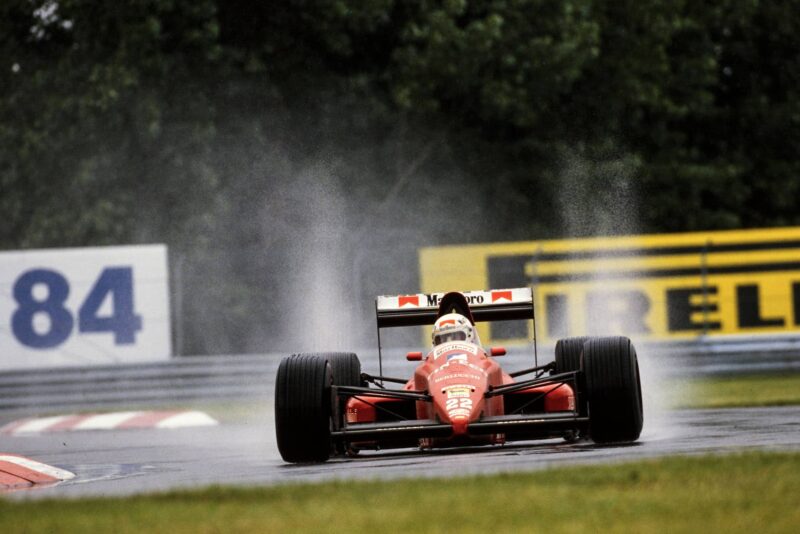
Andrea de Cesaris impressed by taking the final podium spot
Motorsport Images
Either of the Tyrrrells might have been expected to pose a challenge in the conditions, but Michele Alboreto lost his electrics on the opening lap, and fastest-lap setter Jonathan Palmer made a rare mistake on lap 36 coming through the tricky right/left kink at the end of the lap, and slithered into the wall opposite the pits. As the 018 whipped round, it punched a wishbone through the tub, but luckily it passed just above his shins and only grazed them.
Ivan Capelli, too, departed through accident, losing his March CG891 on the approach to Turn One and bumping into the long-abandoned AGS on lap 29.
Having qualified 22nd, where Ligier team-mate Olivier Grouillard failed to make the cut, Rene Arnoux was having something of a crossroads race, many believing hat, had he failed to go well, he might have taken the decision to stand down, By lap five he found himself eighth, and by the time Boutsen wanted to pass he was up to fifth and out to win points for himself and Ligier at all costs. For several corners he gave the Belgian a very hard time, before Thierry slipped ahead.
But Boutsen’s recovery was far from incident-free. Shortly after passing Arnoux on lap 33 came a spin in the infamous kink just past the old pits, through which even in the wet cars go at a good 150mph.
“One minute I was going backwards as fast as I’d been going forwards,” the relieved Boutsen exclaimed later, and it was certainly a very lucky escape. He calmly managed to flick the FW12C back the right way and carried on after hooking a lower gear; the incident cost him barely four seconds!
Then came Riccardo. Never an easy man to pass, the Italian would have been a clear winner had not the two bolts which hold the diffusor supports to the rear wing endplates broken through vibration. With less support, the diffusor generated less downforce, and as Boutsen closed rapidly it was obvious his team-mate was in trouble. That didn’t stop Riccardo squeezing him on to the grass on lap 61 as they exited the hairpin side by side, but it did prevent ultimate retaliation when Williams No 5 finally slipped ahead of Williams No 6 out of Turn One on the following lap.
By then the battle was for second, and the race seemed settled. Senna was going to win again after a performance that rated as one of his best ever, and Williams duo would take a solid two-three. After an up-and-down race due to tyre stops, de Cesaris would be a good fourth, despite a couple of lurid off-course excursions as his rear Pirellis lost grip. Nelson Piquet, who had survived a couple of big moments himself and had almost lost the Lotus right in front of Senna, had driven with something approaching his old spark once he realised points were up for grabs, and was destined for fifth ahead of Arnoux. You could almost hear the sighs of relief in both camps as prequalification had begun to loom.
Alex Caffi was just out of the points after similar problems to de Cesaris, while Christian Danner was the sole remaining runner, soldiering on in the Rial, as Roberto Moreno had finally ground to a halt in the new Coloni with gearbox trouble. The car hadn’t turned a wheel until Friday; Moreno had done very well to qualify it on Saturday, when most others went slower, and had survived the loss of the left front wheel on lap 22 when the securing nut unwound itself. It was a tough debut, but Christian Vanderpleyn’s car clearly is a much more serious contender than the old clunker the team has had to rely on so far this year.
And then it happened. As he passed the pits on lap 66, the rasping wail of Senna’s Honda broke into a throaty belch and suddenly the World Champion was pulling off before Turn One and walking back. Honda was as tight-lipped as ever about the failure, but it is said to have occurred in the bottom end, and to have been mechanical not electronic. It was a cruel end to a great performance, but that didn’t prevent a rousing cheer from erupting as observers worked out that Boutsen was leading.
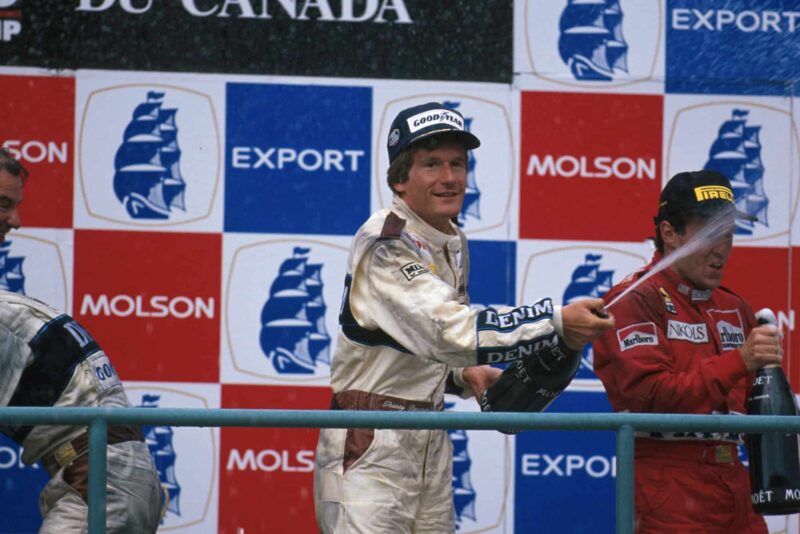
Boutsen sprays the obligatory champagne
Motorsport Images
The man himself had no idea where he was until he saw “P1” on his pit-board, and thereafter became terrified of making another error. He says he took the slowdown lap easy so his tears had time to dry by the time he clambered out, to be greeted first by his old Benetton crew and then by the delirious Williams team.
For sure, McLaren and Honda would fight back, and fast. After all, the transverse gearbox around which the MP4/5 was originally designed was still lurking in the armoury, along with a revised front suspention, but the Canadian result was a fillip for racing, in which a continued domination can exert a negative effect regardless of how deserved it may be. DJT
